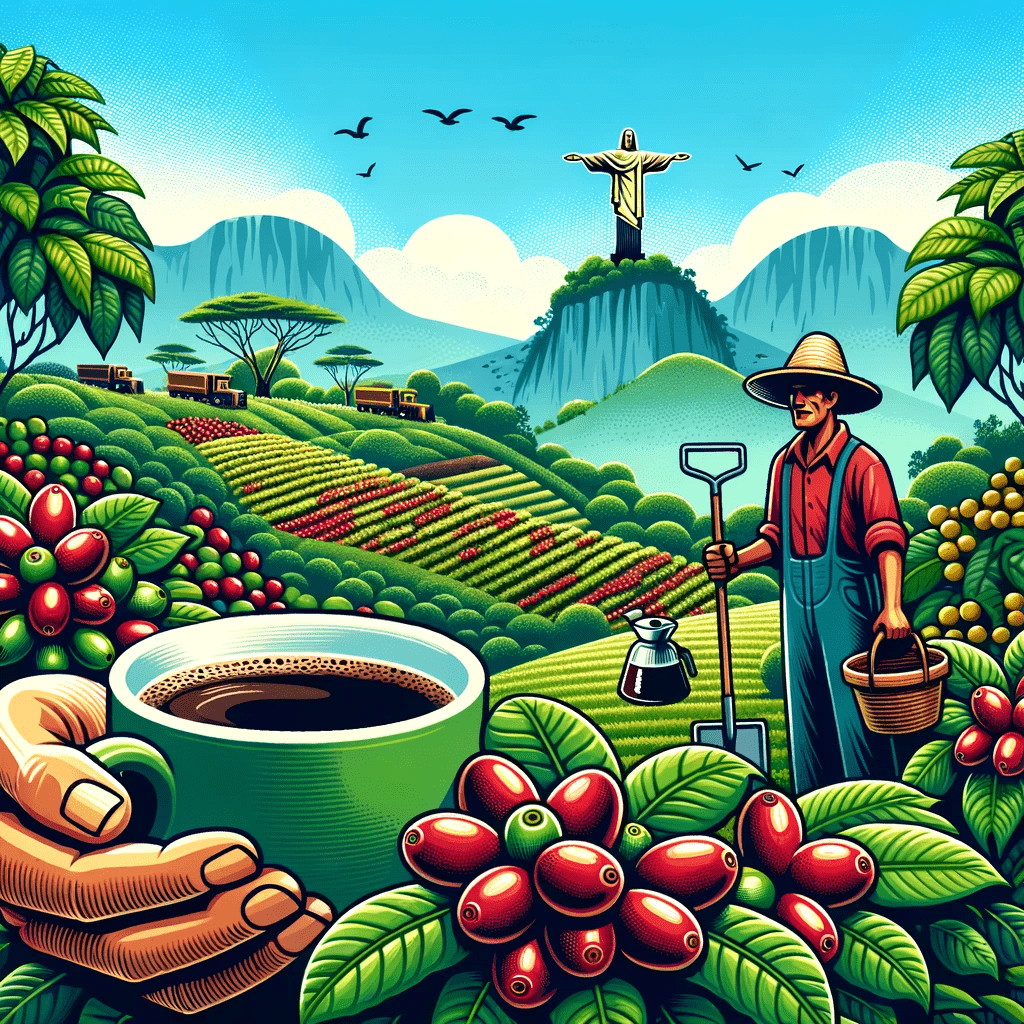Hey, fellow coffee aficionados! 🌱☕
Have you ever taken a moment, while sipping your morning brew, to ponder the journey of that coffee bean? Today, let’s embark on a flavorful adventure into the heart of the Brazilian coffee realm.
As we dig deeper into Brazil’s coffee landscape, I like to think about it from an economy, coffee production, and historical roots perspective. So would like to explore some of these topics via my post.
Economics, Employment, Consumption
Brazil isn’t just another coffee-producing nation; it’s the crown jewel, delivering a staggering 50 million bags annually. Annually, Brazilian coffee constitutes about a third of the global coffee supply. This dominance in production is attributed to Brazil’s favorable climate, vast land area, and innovative farming techniques. But beyond these numbers lies a story of passion, tradition, and resilience. Coffee in Brazil isn’t merely a beverage; it’s a tapestry woven into the very fabric of its culture.
Visualize, if you will, Brazil’s picturesque landscape dotted with over 300,000 coffee farms. From charming family-run plots to vast commercial estates, each has its tale, its legacy. The country’s coffee exports generate billions of dollars annually. As of recent data, Brazil’s coffee exports amounted to over $5 billion, making it one of the country’s top agricultural exports.

But life on these farms isn’t always a bed of roses. With global coffee prices dancing to their erratic rhythm, many small-scale farmers find themselves facing financial headwinds. The coffee prices in Brazil have been volatile due to a combination of internal and external factors.
For example, In 2014, weather dedicated the prices when Brazil faced the worst droughts in decades, especially in coffee-growing regions like Minas Gerais. This drought severely impacted the coffee yield, leading to a sharp rise in coffee prices due to supply concerns.
Conversely, in 2016, excessive rains affected the quality of the coffee beans, leading to a dip in prices for lower-quality beans while increasing the price for premium-quality beans.
Consumption
Now, let’s talk about the coffee-drinking habits of Brazilians. They don’t just grow coffee; they adore it! With over 20 million bags consumed domestically, it’s evident that coffee runs deep in Brazilian veins. And it’s not just about brewing a pot at home. Brazil’s vibrant cities, from the iconic Rio to the bustling São Paulo, are teeming with coffee shops, each echoing Brazil’s coffee heritage. And for those who crave a touch of the familiar, yes, Starbucks has carved its niche here too with over 100 stores now.

Starbucks, the global coffeehouse giant, made its foray into Brazil in 2006, marking its entry into one of the world’s most renowned coffee-producing nations. Despite Brazil’s deep-rooted coffee culture, Starbucks saw an opportunity to introduce its unique blend of coffee experiences and specialty beverages. The company’s entry was strategic, with its first store opening in São Paulo, Brazil’s bustling financial hub (like in many other countries). Starbucks’ approach in Brazil was to celebrate the country’s rich coffee heritage while introducing its global standards and diverse menu.
The average Brazilian spends approximately $50 annually on coffee, a testament to its cultural significance.
Regions of Brazilian Coffee

Diving deeper, while coffee is Brazil’s shining star, it shares the agricultural stage with crops like sugarcane, soybeans, and corn.
Brazil’s vast size means it has multiple coffee-growing regions, each with its unique characteristics
- Minas Gerais:
- The largest coffee-producing state in Brazil.
- Divided into four main regions: Sul de Minas, Cerrado Mineiro, Chapada de Minas, and Matas de Minas.
- Known for its high-quality Arabica beans.
- Coffees from this region often have a medium body, citric acidity, and a nutty, chocolatey profile.
- Espírito Santo:
- Second-largest producer in Brazil.
- Primarily produces Robusta (Conilon) beans, especially in the low-altitude areas.
- The mountainous regions produce Arabica beans with a clear, bright acidity.
- São Paulo:
- Home to the famous Port of Santos, through which a significant portion of Brazil’s coffee is exported.
- The Mogiana region, located along the border with Minas Gerais, is known for its deep, red soil and coffee with a sweet profile and full body.
- Bahia:
- A newer coffee-growing region, especially in the highland areas of Planalto da Bahia and the Cerrado and Atlântico regions.
- Produces both Arabica and Robusta beans.
- Coffees here often have a fruity profile with good acidity.
- Rondônia:
- Located in the western part of Brazil.
- Primarily produces Robusta beans.
- Has seen a decline in production in recent years due to various challenges.
- Paraná:
- It was once a significant coffee producer but faced challenges due to frost, especially in the 1970s.
- The Norte Pioneiro region still produces coffee, known for its bright acidity and medium body.
- Rio de Janeiro:
- A smaller coffee-producing region.
- Coffees from this region are often used in blends.
But the regions of Minas Gerais and São Paulo stand out, with their unique climates and altitudes, crafting beans with unparalleled flavors. If you’re a coffee enthusiast, you’d appreciate how altitude plays a pivotal role in flavor development. Most of Brazil’s coffee thrives between 400 to 1,600 meters, with the harvest season painting the landscape from May to September.
History time!
Coffee’s journey in Brazil began in the 18th century when it was introduced via French Guiana. Legend has it that in 1727, Francisco de Melo Palheta, a Brazilian officer, was sent to resolve a border dispute between the French and the Dutch. During his mission, he was said to have charmed the French governor’s wife, who discreetly gifted him coffee seedlings hidden in a bouquet. Palheta planted these seeds in the state of Pará, marking the inception of coffee cultivation in Brazil.

Fast forward to today, Brazil’s name is synonymous with coffee excellence. From the globally dominant Arabica to the resilient Robusta, Brazil’s coffee spectrum is diverse and flavorful.
Lastly, a nod to ABIC (The Brazilian Coffee Industry Association). Since 1973, they’ve been the torchbearers of Brazil’s coffee legacy, ensuring quality and fostering innovation.
In conclusion, Brazil’s coffee narrative is a blend of history, culture, and economic prowess. Each bean tells a story, each cup an experience. So, the next time you indulge in a Brazilian blend, savor its essence, journey, and soul. Here’s to the magic of Brazilian coffee! ☕🌱
References
- https://en.wikipedia.org/wiki/Coffee_production_in_Brazil
- https://www.origincoffee.co.uk/blogs/journal/brazil-coffee
- https://thebrazilbusiness.com/article/brazilian-coffee-industry
- https://www.britannica.com/video/72970/Brazil-producer-world-coffee-beans
- https://www.nomadcoffeeclub.com/pages/brazil
- https://kafebeans.com/everything-about-coffee-from-peru/
- https://kafebeans.com/world-coffee-colombia/

